What Is Blackboard?
Blackboard is a Web-based suite that facilitates learning management and is designed to support online education and e-learning. Blackboard Learn is one of the products in the suite, offering end-to-end solutions for managing, delivering, and assessing online courses.
It was developed to enhance teaching and learning processes within an academic environment. Blackboard Learn integrates very well with Student Information Systems, with extensions available for mobile devices.
It enables better communication and collaboration between teachers and students, as it facilitates online and blended learning through a central location of course materials and assignments with a set of assessment and grading options that gives teachers the ability to know exactly where each learner is. COURSEtools contains a whole set of tools for course management, communication, content delivery, collaboration, and analytics, all of which can assist in extending the classroom experience and supporting distance education.
- What Is Blackboard?
- Key Features of Blackboard LMS
- How to Make A Quiz in Blackboard?
- Best Alternative Quiz Maker to Blackboard for Teachers
- How to Create A Quiz in OnlineExamMaker?

Key Features of Blackboard LMS
Administration
• Product onboarding
• Scheduled reports
• Reports can be exported in different formats
• Calendar of offline training events
• Activity Stream
Content
• A built-in authoring tool with generative AI capabilities
• Can generate learning modules
• Can generate tests
Here is the revised text in a plagiarism-free manner:
• 1. Offers image suggestions or generation
• 2. Supports a wide range of formats including SCORM, LTI, MP4, MP3, PDF, DOC, XLS, and PPT
• 3. Facilitates assignment creation
• 4. Enables control over content visibility
• 5. Allows combining various contents to create courses
• 6. Permits the addition of discussions and journals within a course
Includes User Management Capabilities
• Bulk user import
• Self-registration
• Custom user roles with a variety of privileges that can be assigned
• Institutional hierarchy and domains
User Experience and Social Learning
• Intuitive learner interface
• Mobile app with offline learning support
• Certificates for course completion
• Direct messaging from user to admin
• Gamification with scoring, levels, and badges
• Notifications (browser, push messages on mobile devices)
• Direct messages to instructors and classmates
• Discussion forums
Customization and Integrations
• Interface color can be changed
• Preset themes Can upload the institution’s logo
• Integration with plenty of teaching tools
• Single sign-on
• API for custom integrations
Advantages of Blackboard
Search Options for Students
Blackboard is accessible and user-friendly, featuring several navigation tools that make it easy and intuitive for students to find what they need. The menu structure is great, so students in the class should be able to quickly find announcements, course content, grades, and discussion boards. Students would be able to create personalized lists of courses and set notification options to further tailor their experience. By searching, students would identify what they are looking for in the course by merely typing keywords, thus saving them time and consequently making navigation very easy.
Mobile App Functionality
Blackboard’s mobile app functionality drastically improves the aspects of accessibility and user-friendliness. It provides an easy experience to users for viewing course materials, submitting assignments, participating in discussions, and communicating with instructors anywhere and at any time. Some of the key benefits are:
• Convenience: Stay connected to courses without a computer to create a flexible learning environment.
• Accessibility: Easily access all the critical information about courses to keep students up-to-date and engaged.
• User-Friendly Interface: It has an intuitive design that enhances ease of navigation, finding relevant materials, and engaging with the content.
Customization for Instructors
Blackboard provides extensive customization options for instructors. All these customizations are targeted at increasing the accessibility and user-friendliness of the facility. The instructors can change the layout, organization, and content of their classes to suit teaching needs. This will allow students to easily move around and engage with the material. It also contains customization features that enable the personalization of announcements, reminders, and feedback to the students. All these bring forth a more personalized kind of learning atmosphere. Instructors can choose to tailor the assessments that can help meet teaching goals, thus suiting different teaching styles and preferences.
Better Communication and Collaboration
Blackboard enables smooth interaction and group work through its Communication and Collaboration features:
• Discussion Boards: Effective discussions, peer reviews, and sharing of knowledge outside the physical classroom.
• Collaborative Tools: Group projects, wikis, and blogs allow students to collaborate and share resources while creating collective knowledge.
• Announcements and Notifications: Timely updates and deadlines can be issued to students by instructors for effective communication and participation in class.
Course Management Made Easy
Blackboard eases the process of course management for teachers and learners alike, thus creating a better way of organizing and coordinating academic resources and activities. These involve:
• One Centralized Platform: Syllabi and assignments, grades, and all other documents can be posted in one place to make information distribution less cumbersome.
• Calendar feature: Deadlines, exams, and activities are put in place to help students organize their time well.
• Grade book function:This way, grade calculations are automated; hence, progress can be easily kept, and feedback can be done on time to the educators.
• Collaboration: Group projects and online class discussions are provided for to enhance teamwork and better learning
Disadvantages of Blackboard
Possible Technical Issues
The users may experience a number of technical issues which may affect their satisfaction. These include:
• Loading Time Issues: Long loading times delay access to course materials and reduce interactivity, leading to frustration.
• Login Authentication Issues: Isolated cases of issues with login credentials or server errors, or maintenance activities in general disturb the access.
• File Upload Issues: File size limits, format incompatibility, and issues with the network are some of the reasons that generally cause problems with document sharing.
Limited Customization Options
It does not allow much customization by the user. The absence of themes, color schemes, or layout options generally creates a very generic interface that makes it hard to adapt the platform to offer personalized experiences or institutional branding. This lack of personalization will only decrease user engagement and motivation and lead to less immersive learning.
How to Make A Quiz in Blackboard?
Step 1: Log in to Blackboard
1. Log into your Blackboard account.
2. Go to the course in which you wish to create the quiz/test.
Step 2: Access the Tests, Surveys, and Pools Section
1. Open the Course Menu by clicking on the course name.
2. Go to the Control Panel on the left side of the screen.
3. Click on Course Tools.
4. Click on Tests, Surveys, and Pools.
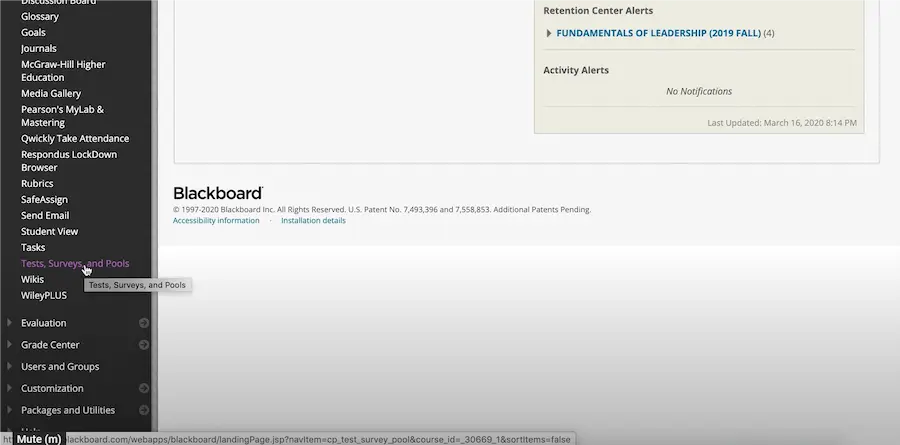
Step 3: Create a New Test
1. Click on Tests.
2. Click on Build Test.
3. Enter the Test Information:
o Name: Enter a name for your test.
o Description: (Optional) Provide a description for your test.
o Instructions: (Optional) Provide instructions for your test.
4. Click Submit.
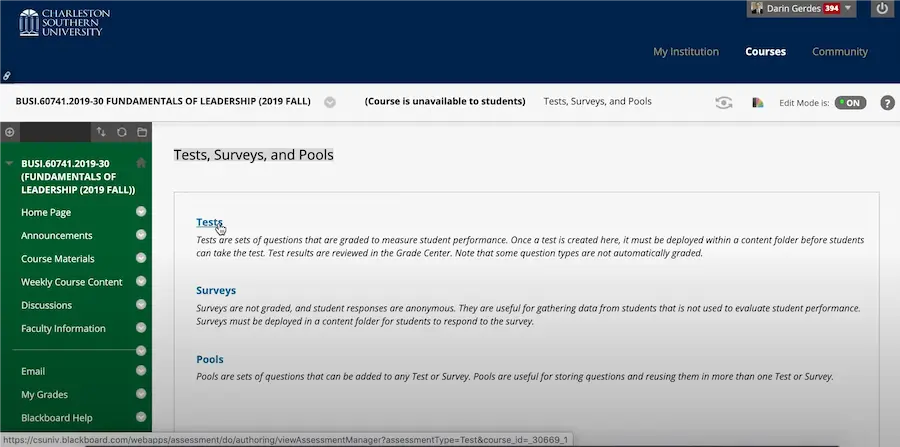
Step 4: Add Questions to the Test
1. After creating the test, you will be directed to the Test Canvas page.
2. Click on Create Question and choose the type of question you want to add (e.g., Multiple Choice, True/False, Short Answer, etc.).
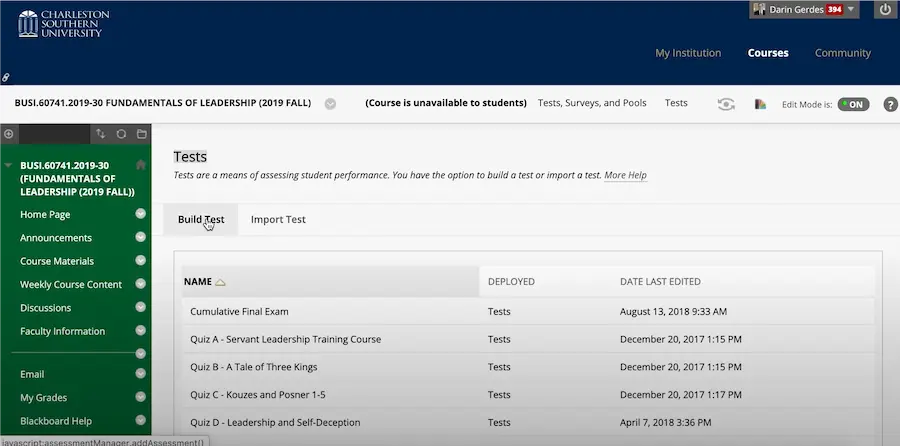
Step 5: Fill in the test information
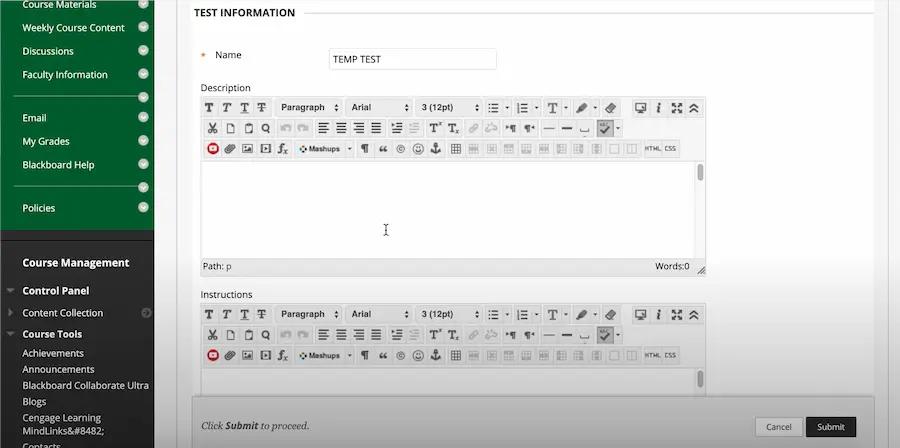
Step 6: Create Questions
1. For each question type:
o Multiple Choice:
✔ Enter the question text.
✔ Provide answer choices.
✔ Select the correct answer.
o True/False:
✔ Enter the statement.
✔ Select True or False as the correct answer.
o Short Answer/Essay:
✔ Enter the question text.
✔ Set the number of rows for the answer field.
2. Provide Feedback: (Optional) Enter feedback for correct and incorrect answers.
3. Assign Points: Enter the number of points for each question.
4. Click Submit to add the question to the test.
5. Continue adding questions until your test is finished.
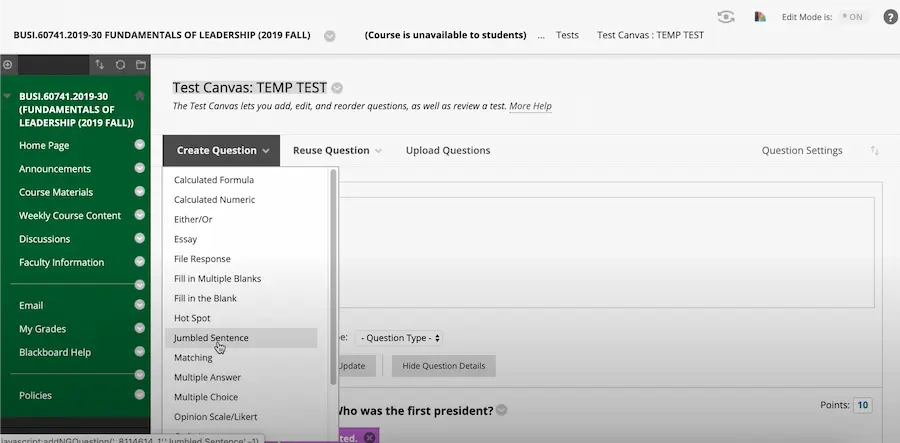
Step 7: Set Test Options
1. Test Availability:
o Make the link available: Yes or No.
o Add a new announcement: Yes or No.
o Multiple attempts: Allow or disallow multiple attempts.
o Force completion: Yes or No.
o Set timer: Enter time limit.
o Display after/until: Set start and end dates and times.
Step 8: Deploy the Test
1. Return to the Course Content area where you want to add the test (e.g., a specific content folder or module).
2. Click on Assessments and select Test.
3. Select the test you created from the list and click Submit.

Step 9: Monitor and Grade the Test
1. Once students start taking the test, you can monitor their progress and submissions from the Grade Center.
2. Grade any questions that require manual grading (e.g., essays) and review overall test results and statistics.
Following these steps will help you create, configure, and deploy a quiz/test in Blackboard effectively.
Best Alternative Quiz Maker to Blackboard for Teachers
Upgrading to alternative online assessment tools that have better usability and more innovative features can really make a difference in the teaching experience. The following three are outstanding options, with OnlineExamMaker leading the pack:
1. OnlineExamMaker
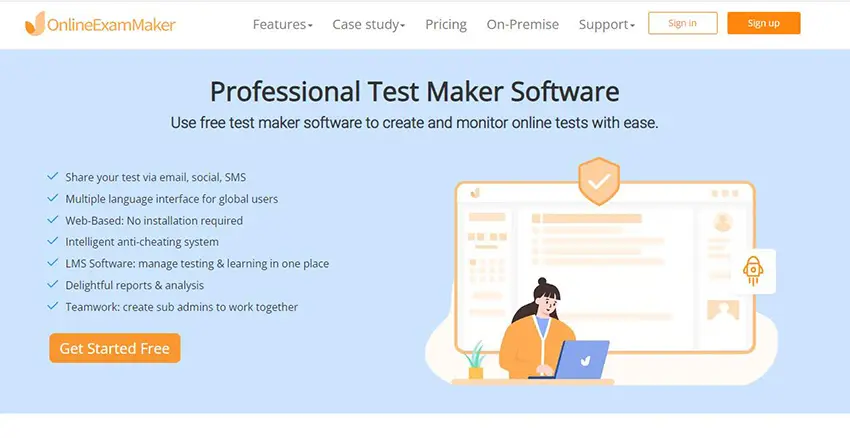
OnlineExamMaker is the all-in-one quiz maker designed to be easily used in creating and managing any type of assessment. It provides excellent user-friendliness and customization, which makes it just perfect for teachers to generate engaging quizzes with ease.
Key Features:
• User-Friendly Interface: Intuitive tools for easy quiz creation.
• Customization Options: Options to personalize your quizzes with multiple question types and theming.
• Analytics and Reporting: Extensive tracking and analytics on student performance.
• Security Features: Allowances for secure online testing environments.
Create Your Next Quiz/Exam with OnlineExamMaker
2. Google Forms
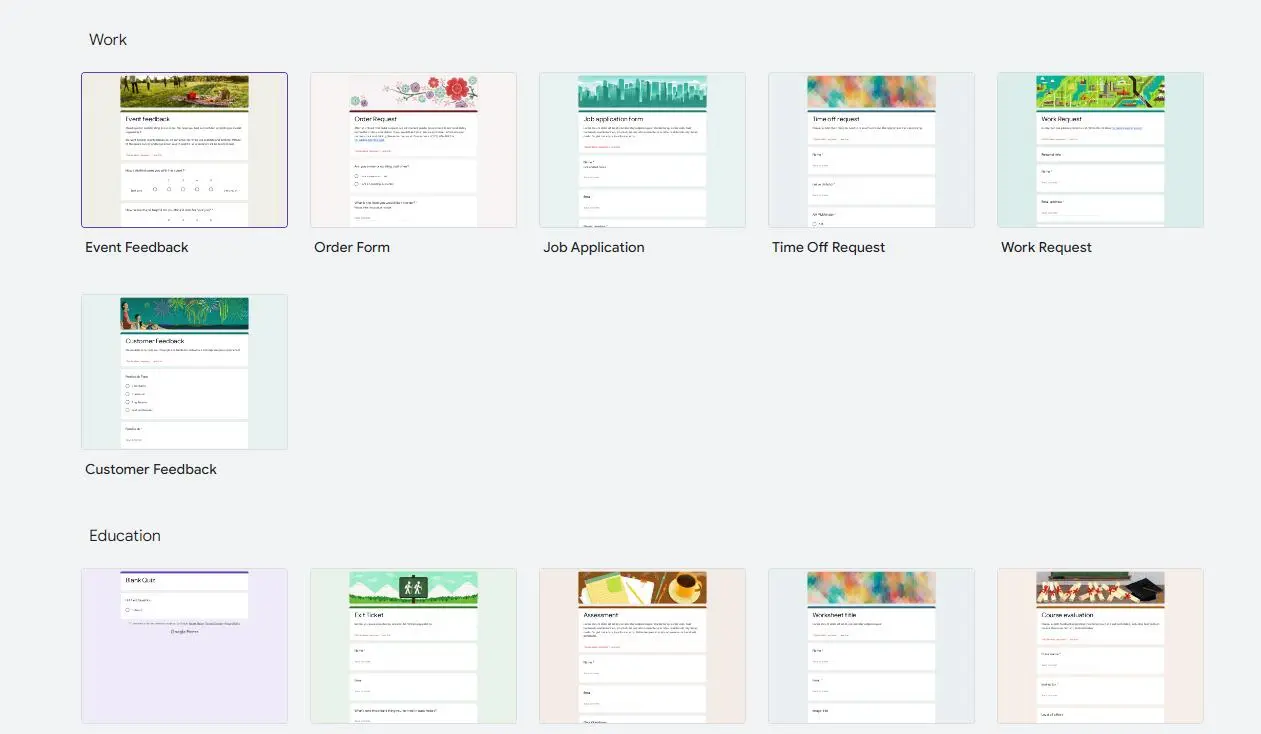
Google Forms is a very simple way to create a quiz, and it is really well integrated with Google Workspace. It has the essential toolkit that helps teachers to assess and provide feedback efficiently.
Key Features:
• Integration: Integrates well with both Google Classroom and Google Sheets.
• Question Variety: Multiple choice, short answer, and more.
• Analytics: Automated data capture, extremely easy reporting
• Accessibility: It works on a number of devices, and thus provides flexibility to the student.
3. Quizizz
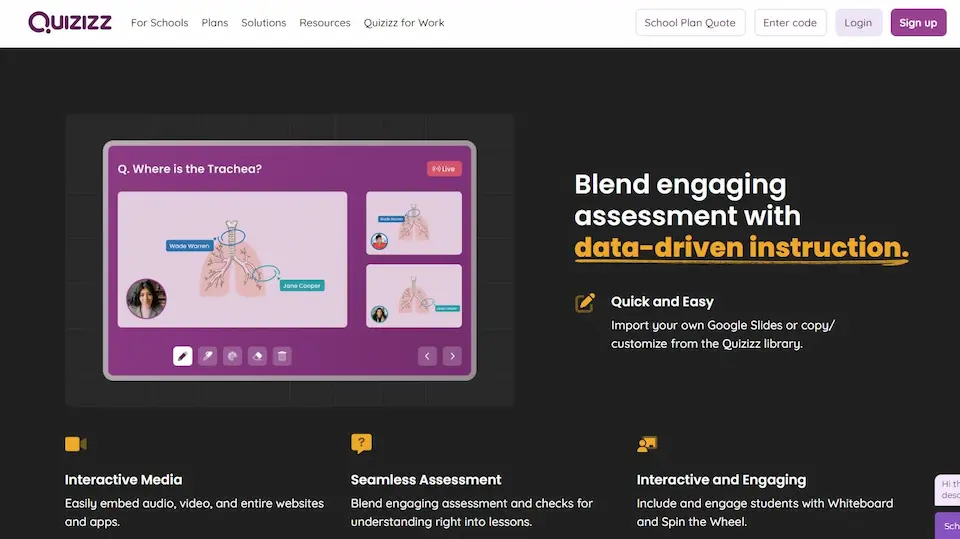
Quizizz transforms quizzes into a game to advance engaging and motivating interactive learning experiences among learners.
Key Features:
• Game-based Learning through points, leaderboards, and memes to boost student participation
• Unique Modes of access: Live quiz or as homework
• Data Insights: Real-time Feedback and performance analytics
• Integration: Integrates well with Google Classroom for seamless workflow.
These devices by quiz makers range from a host of features that can be used to increase classroom engagement and aid the teacher with his assessment processes. And the best alternative that you can use is the number one in our list, OnlineExamMaker. Compare to Blackboard and other platform online, OnlineExamMaker is much easier to use and offers more flexibility and features that is useful in test creation. You can try it yourself OR let’s just show you!
How to Create A Quiz in OnlineExamMaker?
Below is the step-by-step tutorial to make a professional quiz using OnlineExamMaker, the best Blackboard quiz maker alternative.
Create Your Next Quiz/Exam with OnlineExamMaker
Step 1: Get Started with OnlineExamMaker
On the extreme left side of your screen, click the ‘Exams’ button. Then “New Exam” button to set up an online exam.
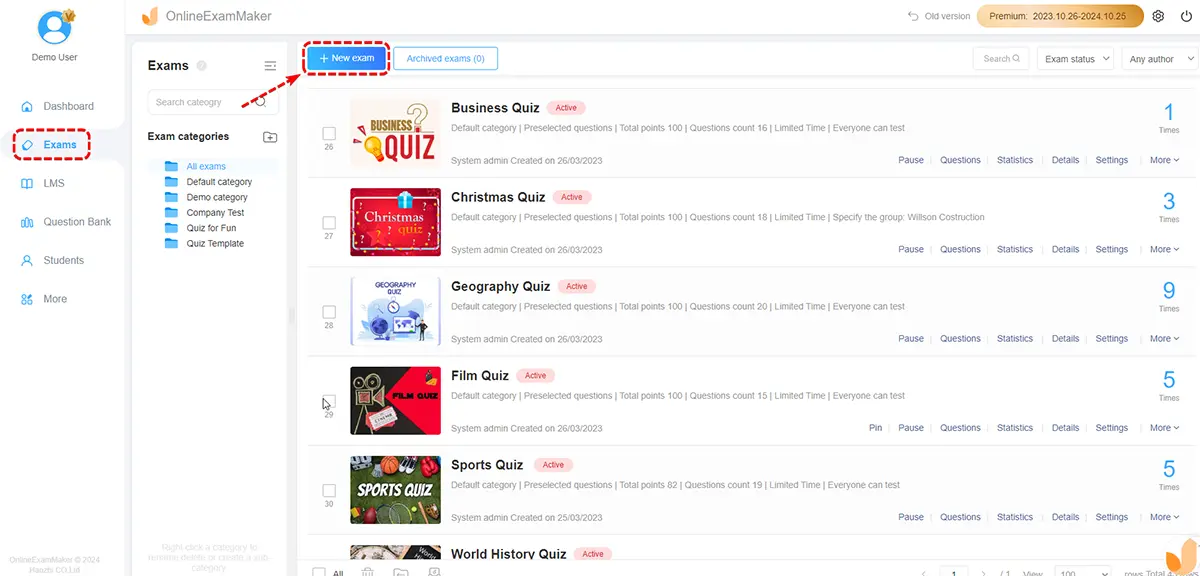
Step 2: Fill in the Details
Now, fill in the details of the test. Scroll down and select the mode of progression. Put an appropriate title for your online test. Click ‘Advanced Setting.’ Put an appealing cover, add keywords to your test, write a brief message or description. Click ‘Save and Next’ to proceed.
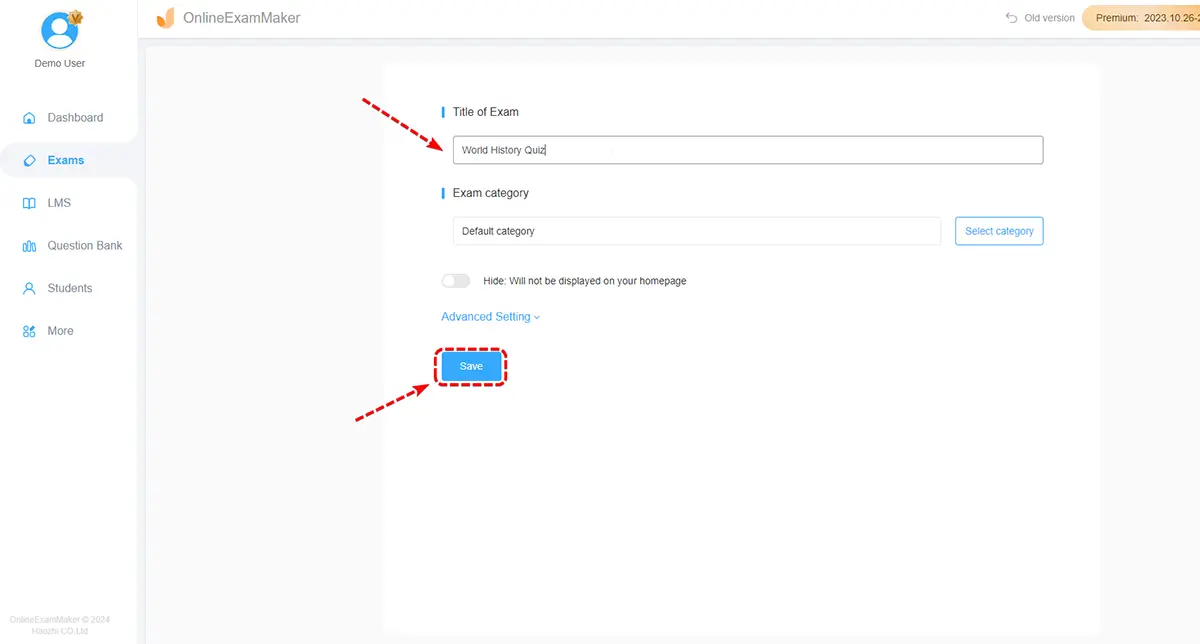
Step 3: Add Questions
In this step, manage the order of your questions. After that, add ‘Test Qualifications.’ Now, from the question bank, set questions and rewards for your students. ‘Save and Next’ to move on.
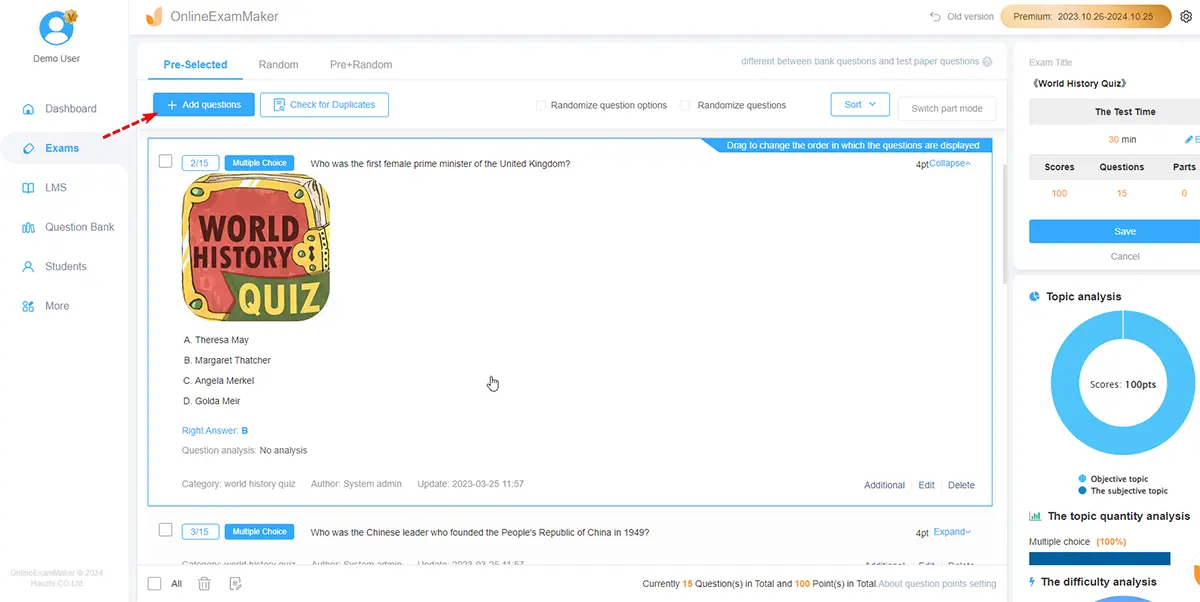
Step 4: Personalize The Test
Now, in this section, customize test time, rules, attempts, and exam login options. Choose an attractive theme for your test. Once you are all done, click the ‘Save’ button.

Step 5: Publish Your Virtual Test
The final step is to publish your test. Click again on the tab ‘Exams,’ then select ‘Prize Test.’ Click ‘Publish.’ Now your test is ready! Share your test link or QR code with your students.
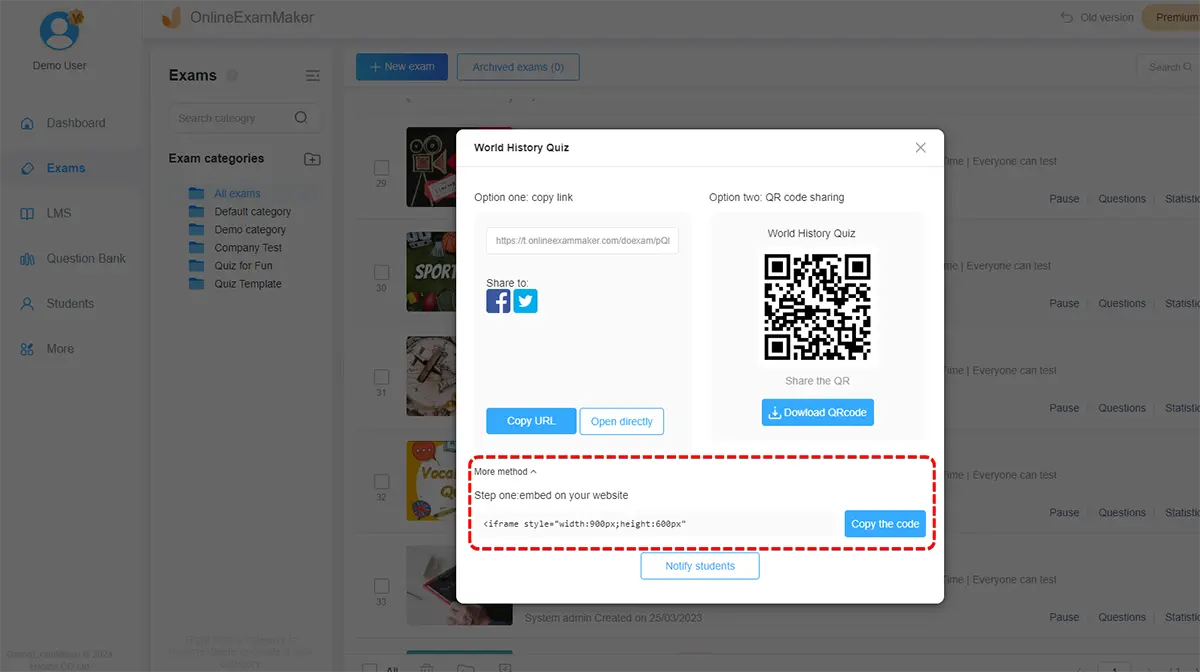
Of all the existing options to create quizzes outside Blackboard, OnlineExamMaker is the best tool that gives all options to many teachers in their effort to try making more innovative teaching techniques. With this interface, which is user-friendly, teachers are in a position to easily generate different question quizzes, from multiple-choice and short-answer ones to others. It also provides more advanced settings, with time limits, criteria for scoring, and the option of choosing a theme for the quiz to suit the assessments used to achieve instructional goals.
It also offers the educator or teacher very robust analytical and reporting enhanced features to gain deep knowledge with regards to the performance of students and areas they have to improve on. It is a data-driven approach, which helps in targeted instruction but effectively supports formative assessment strategies as well.
Relating to a user-friendly interface, flexibility, and features, OnlineExamMaker is the best solution available to teachers who want to design fun, engaging quizzes, that greatly influence the learning outcome of students.